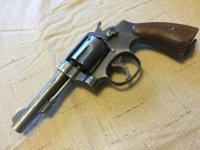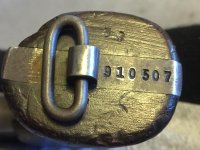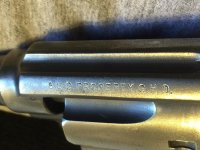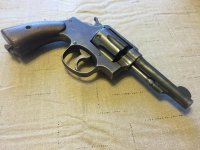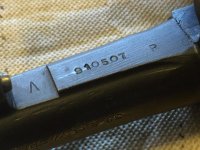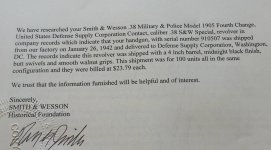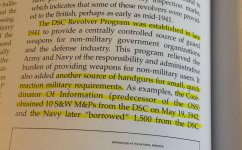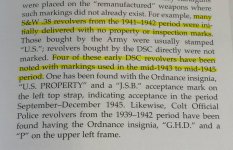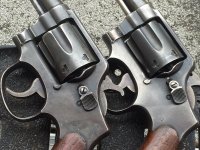Absalom
SWCA Member, Absent Comrade
I recently acquired the pre-Victory #910507 pictured below. At $380 not a steal (I didn't find out until afterward I was bidding against another forum member), but interesting enough to be well worth adding to my collection. All-matching including the stocks.
This gun was produced in early 1942 just shortly after the smooth walnut stocks replaced the checkered medallion style. If I interpret DWalt's Pre-Victory/Victory Timeline correctly, the fact that this gun's utility finish is noticably different from my later Victorys is due to the Black Magic oxide finish being used at that time (in contrast to the later Midnight Black phosphate).
The interesting part about this gun are the stampings. As mentioned, the serial would place its production in early 1942, yet it bears the stampings of a 1943 or later gun. According to Pate, not until April 1943 was the U.S.PROPERTY stamping found on this gun applied to US Victory models; it also has the P proofs in the post-1943 locations (under barrel, side of frame, cylinder face). Col. Drewry's G.H.D. initials appear somewhat earlier, but Pate states V85,000 as the lowest-numbered S&W revolver so stamped.
Since the ordnance inspectors did their work at the S&W factory, I suspect the gun took a trip back to Springfield at some time during the war. It does not have the S, any re-work star or re-work date stamp.
The only other explanation would be that it was held back at the factory for over a year before shipping; that did happen, I have another Victory to prove it. So I really look forward to new letters being processed so I can find out the ship date.
This gun was produced in early 1942 just shortly after the smooth walnut stocks replaced the checkered medallion style. If I interpret DWalt's Pre-Victory/Victory Timeline correctly, the fact that this gun's utility finish is noticably different from my later Victorys is due to the Black Magic oxide finish being used at that time (in contrast to the later Midnight Black phosphate).
The interesting part about this gun are the stampings. As mentioned, the serial would place its production in early 1942, yet it bears the stampings of a 1943 or later gun. According to Pate, not until April 1943 was the U.S.PROPERTY stamping found on this gun applied to US Victory models; it also has the P proofs in the post-1943 locations (under barrel, side of frame, cylinder face). Col. Drewry's G.H.D. initials appear somewhat earlier, but Pate states V85,000 as the lowest-numbered S&W revolver so stamped.
Since the ordnance inspectors did their work at the S&W factory, I suspect the gun took a trip back to Springfield at some time during the war. It does not have the S, any re-work star or re-work date stamp.
The only other explanation would be that it was held back at the factory for over a year before shipping; that did happen, I have another Victory to prove it. So I really look forward to new letters being processed so I can find out the ship date.
Attachments
Last edited:

